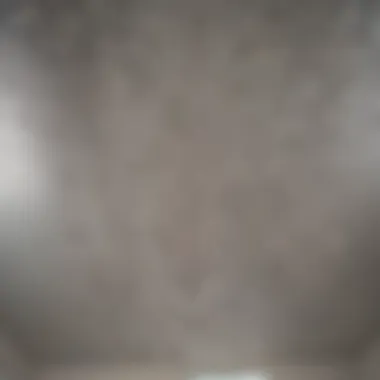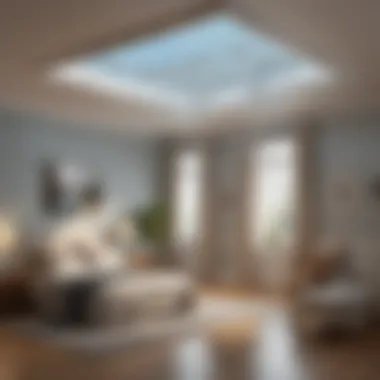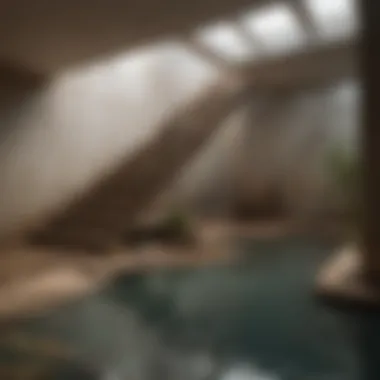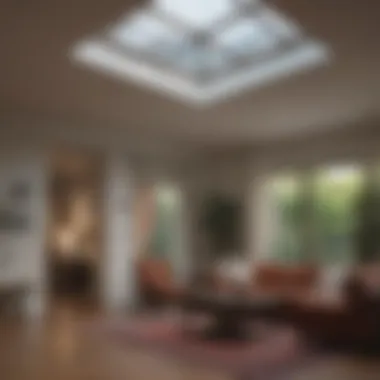Comprehensive Guide to Ceiling Leak Management


Intro
Water intrusion in ceilings can be a serious concern for homeowners and renters alike. It is not merely an aesthetic issue; it can lead to significant structural problems, increased repair costs, and health risks due to mold growth. Understanding the causes behind ceiling leaks is crucial for effective remediation and prevention.
In this comprehensive guide, we will explore various aspects of managing water intrusion. We will detail how to identify leaks, address their underlying causes, and implement cost-effective solutions. This guide aims to empower individuals living in residential properties with the knowledge needed to tackle this pressing issue proficiently.
As we delve into this topic, we will cover the importance of regular maintenance checks, the role of environmental factors, and practical steps for remediation. By the end of this article, readers will gain insight into both the immediate and long-term strategies for dealing with ceiling leaks, ensuring peace of mind in their living spaces.
Understanding Water Intrusion
Water intrusion can be a silent yet profound threat to any dwelling. Recognizing its importance is key for homeowners to maintain the structural integrity of their properties. Ignoring the signs of water intrusion can lead to expensive repairs and health hazards, such as mold growth. Therefore, understanding the mechanisms behind water intrusion is crucial for effective management.
In our guide, we will delve into two critical aspects that form the foundation of water intrusion: the definition of water damage and the identification of water sources. This understanding not only aids in timely interventions but also emphasizes the importance of preventive measures.
Definition of Water Damage
Water damage refers to the destruction or deterioration of material caused by the presence of water. This damage can happen gradually or suddenly. For instance, a slow leak may only become apparent after months of unnoticed leaking, culminating in mold and structural issues. On the other hand, a sudden flood can result in immediate and severe damage.
There are generally three key types of water damage:
- Clean Water Damage: This occurs from sources like broken pipes or rain. It is the least harmful and can often be managed effectively with quick remediation.
- Grey Water Damage: This is water containing some contaminants, such as from dishwashers or washing machines. While not as harmful as sewage, it still requires prompt attention to prevent health risks and further damage.
- Black Water Damage: This type includes sewage or floodwaters. It is highly contaminated and poses serious health risks, necessitating professional intervention.
Understanding these types is essential for determining the implications of water damage within the home environment.
Identifying Water Sources
Identifying the source of water intrusion is often a challenging but necessary step. Possible sources may not always be immediately visible. Here are common culprits that can lead to water issues in ceilings:
- Roof Leaks: Damaged roofing shingles, poor flashing, or clogged gutters can allow water to enter through the roof, often showing up in ceilings.
- Plumbing Issues: Broken pipes or faulty fixtures can lead to slow leaks that compromise ceilings, especially those directly beneath bathrooms or kitchens.
- Condensation Problems: Insufficient insulation in attics can cause moisture to condense on cooler surfaces, leading to dripping in ceilings below.
Addressing these sources promptly can mitigate damage and prevent escalation.
Regular inspections and maintenance can greatly reduce the risk of water intrusion, saving homeowners significant costs in repairs.
Common Causes of Water in Ceilings
To effectively manage ceiling leaks, it's crucial to understand their causes. Water intrusion can lead to significant structural damage, increased repair costs, and health issues if not addressed promptly. Identifying these common culprits offers homeowners the ability to take preventive measures and react swiftly to leaks. This knowledge not only serves as a foundation for effective repairs but also helps in making informed decisions regarding maintenance and renovations.
Roof Leaks
Roof leaks are a primary cause of water intrusion in ceilings. They often arise from missing shingles, cracks, or weathering of roofing materials. Over time, roofs can deteriorate, allowing water to seep into underlying structures. It is important to regularly inspect the roof, especially after heavy rain or snow. Look for any signs of damage or wear, and consider hiring a professional for a thorough examination of the roof's condition. If a leak is detected, prompt repairs can save homeowners from expensive renovations later on.
Plumbing Issues
Leaking pipes can release water into ceilings, causing discoloration and structural problems. Common plumbing issues include faulty connections, corroded pipes, or improper installations. Homeowners should periodically inspect their plumbing systems and be attentive to any changes in water pressure. A sudden increase in water stains may indicate a leaking pipe that needs immediate attention. If necessary, a plumbing professional can help locate and resolve these issues before they escalate into something more severe.
Condensation Problems
Condensation is another potential cause of water intrusion, often overlooked. It usually occurs when warm, moist air comes into contact with cooler ceiling surfaces, leading to water droplets forming. Factors contributing to condensation can include inadequate insulation, poorly ventilated attics, and temperature differences inside and outside the home. Preventive measures such as increasing ventilation, using dehumidifiers, and insulating pipes can help reduce the risk of condensation. Homeowners are encouraged to monitor areas that may be prone to excess moisture.
Understanding these common causes is key to preventing water damage and maintaining the integrity of your home.
Identifying Symptoms of Water Damage


Understanding the symptoms of water damage is crucial for any homeowner. Recognizing these signs early can prevent further deterioration of your property and save you from costly repairs. Water intrusion can often go unnoticed until significant damage occurs. This section delves into various indicators of water damage, including visible signs, structural concerns, and associated risks, specifically mold growth.
Visual Indicators
Visual indicators are often the most immediate signs of water damage. Homeowners should be vigilant for discoloration or stains on ceilings and walls. A brownish or yellowish stain suggests long-term exposure to moisture. Peeling or bubbling paint or wallpaper indicates water presence behind the surface, damaging the integrity of the material. A sagging ceiling can signal a significant accumulation of water, requiring urgent attention.
Sometimes, the problem starts subtly. Small, dark spots can develop, signifying mold areas, which signal moisture under the surface. It’s recommended to perform regular visual inspections in areas like attics or basements. Look for patches or stains, as this can help identify water intrusion before it escalates.
Structural Concerns
Water damage impacts more than just aesthetics; it raises significant structural concerns. Moisture can weaken and warp structural elements like beams and joists. This degradation compromises the whole building’s integrity, posing safety risks. Over time, insulation can also be compromised due to persistent moisture, leading to increased energy costs and promoting an unhealthy living environment.
To ensure safety, an assessment of visible oddities, like cracks in walls or sagging ceilings, is essential. These can indicate weakened supporting structures directly affected by water intrusions. Homeowners should consider hiring professionals for a thorough inspection whenever they notice signs of distress.
Mold Growth Risks
Mold growth poses a serious health hazard that often accompanies water damage. Fungi thrive in moist environments, establishing colonies in hidden areas like behind walls and inside ceilings. Exposure to mold can cause respiratory issues, allergies, and other health problems. The risk escalates with prolonged moisture, underscoring the significance of early detection.
To mitigate mold risks, it is imperative to address any water leak or intrusion immediately. Conducting regular checks for signs of dampness in both common and less visible areas of the home prevents mold spores from thriving. Homeowners are advised to maintain low humidity levels indoor and use dehumidifiers where necessary. Taking these preventive steps is vital in safeguarding both property and health.
Important: Addressing visible indicators, structural concerns, and mold growth risks quickly can mitigate serious potential consequences.
Immediate Actions to Take
Addressing water intrusion in your home requires timely and effective action. When leaks occur, immediate measures can mitigate damage and prevent further complications. Recognizing the urgency and knowing what steps to take may save homeowners from extensive repairs and financial burdens. In this section, we will explore crucial immediate actions to manage ceiling leaks effectively.
Shutting Off Water Supply
One of the first steps when encountering a ceiling leak is to shut off the water supply. This action halts the flow of water and can prevent more serious damage to the structure of your home and its contents.
It is vital to locate the main water shut-off valve, typically found near the water meter or where the main line enters your home. Depending on your plumbing system, you may also need to shut off individual valves for specific fixtures affected by the leak.
Here are important considerations when shutting off the water supply:
- Know Your Valves: Familiarize yourself with the location and operation of shut-off valves in your home before an emergency arises.
- Timeliness: The sooner you can cut the water supply, the less damage will likely occur. A few minutes can make a significant difference.
- Aftermath: Once the water is off, it is crucial to assess the extent of the leak and consult professionals or take further action as needed.
By taking these steps, you limit the possibility of damage escalating.
Creating Emergency Drainage
After turning off the water supply, the next action is to create emergency drainage. This process involves directing water away from the affected area to minimize damage. Instead of waiting for the water to accumulate, swift action allows you to manage the situation better.
To create effective emergency drainage, consider the following:
- Safer Exit Points: Use buckets, containers, or even towels to collect dripping water. If water builds quickly, use higher-capacity containers to mitigate overflow.
- Strategically Place Containers: Position the containers directly under leaks. If the damage involves more significant flooding, consider opening windows or doors for faster evaporation.
- Determine Alternative Solutions: In cases of extreme leaks, you might need to create temporary drainage systems. This could involve routing water towards drains or exterior areas away from the house.
"Creating efficient drainage is vital in limiting ceiling and structural damage as well as preventing mold issues."
In summary, immediate actions are critical in managing leaks. Shutting off the water supply followed by effective drainage helps protect your home from further damage. These steps should be prioritized in the event of a ceiling leak to maintain your home’s integrity.
Assessing the Damage
Assessing the damage caused by water intrusion in ceilings is a crucial step to determine the extent of repairs needed and to prevent further complications. This process involves examining not only the visible signs of water damage but also underlying issues that may not be immediately apparent. In doing so, homeowners can avoid future problems and costly repairs.


Proper assessment can identify risks such as mold growth or structural weaknesses, which are significant concerns for any building. Timely evaluation means that any necessary treatments can be carried out effectively, ensuring the safety and longevity of the home.
Professional Inspection
Engaging a professional for an inspection can offer an unbiased perspective on the severity of the water damage. Experts in this field have the tools and experience to detect issues that may not be visible to the untrained eye. They perform comprehensive evaluations, checking for moisture levels, structural integrity, and potential hazards such as electrical risks.
Some benefits include:
- Thorough Inspection: Professionals often use moisture meters and thermal imaging cameras, allowing them to diagnose hidden problems.
- Expert Recommendations: They provide tailored advice on remediation strategies, helping homeowners make informed decisions about repairs.
- Documentation: An inspection report from a professional can serve as valuable documentation for insurance claims, providing evidence of damage when seeking compensation.
DIY Evaluation
For homeowners considering a more hands-on approach, a DIY evaluation can also yield significant insights into ceiling leaks. While this method may lack the precision of a professional assessment, it helps identify obvious problems that can be addressed promptly.
Steps for a DIY evaluation may include:
- Visual Inspection: Look for water stains, peeling paint, or mold growth on the ceiling or walls.
- Feel for Dampness: Gently touch areas of the ceiling to check for softness or dampness, which indicates possible water intrusion.
- Assess Water Sources: Check for any visible plumbing issues, roof conditions, or drainage problems that could be causing leaks.
While assessing the damage on your own can give a clearer picture of the situation, it is wise to consider a professional evaluation for more serious issues or if you are unsure about what you find. The results of either approach will guide the next steps in managing and repairing water intrusion effectively.
Repairing Water Damage
Repairing water damage is crucial for maintaining the safety and integrity of a home. Water intrusion can lead to various problems, such as structural instability, health hazards like mold growth, and even financial burdens due to extensive repairs. Understanding how to efficiently address water damage can mitigate these risks and restore your living space to its original condition. This section outlines key techniques and considerations that homeowners must take into account when facing ceiling leaks.
Ceiling Repair Techniques
Effective ceiling repair begins with a thorough assessment of the damage. Homeowners need to determine the extent of water infiltration, as this can inform the repair process. Depending on the severity of the damage, individuals may consider the following techniques:
- Patching Small Holes: If water leaks have caused minor fractures in the ceiling material, patching may suffice. Use a patching compound for drywall or plaster to fill the gaps, and sand it smooth once dry.
- Replacing Damaged Panels: When leaks lead to significant degradation, replacing the entire ceiling panel could be necessary. This involves removing the damaged section and installing new drywall or ceiling tiles, ensuring proper sealing to prevent future leaks.
- Reinforcing Structural Elements: Ceiling components, such as joists, may weaken due to prolonged exposure to water. Reinforcing these elements through the addition of support beams or other structural enhancements may be required.
- Applying Water-Resistant Coatings: Once the repairs are made, applying a water-resistant sealant can provide an additional layer of protection against potential future leaks. This is especially useful in areas prone to high moisture.
Repairs should always be done with attention to safety. Ensure that any electronic fixtures, such as lights or fans, are disconnected before starting work.
Wall Repairs Linked to Ceiling Issues
It is vital to recognize that ceiling issues often correlate with wall problems. Water intrusion can affect both surfaces, and addressing only one may leave the other compromised. Here are key points to consider when handling wall repairs linked to ceiling water damage:
- Assessing Water Stains: Water stains on walls often indicate leaks. These stains should be carefully examined to identify the source and extent of damage. Routine cleaning does not guarantee thorough remediation, and deeper issues may persist if not addressed.
- Checking for Mold: Damp walls can encourage mold growth. If visible mold appears, homeowners must utilize mold removal techniques or consult professionals to ensure safe and effective remediation.
- Repairing Drywall: Much like ceilings, walls may need patching or replacement if severely damaged. Monitor moisture levels, and implement proper sealing methods after repairs to prevent recurrence.
- Painting and Finishing: Post-repair painting can not only restore aesthetics but also protect surfaces. Choosing paints that contain mildew-resistant properties can help combat future moisture accumulation.
Final Consideration: Remember, repairing water damage is not just an aesthetic endeavor. It reinforces the safety and longevity of your home.
Assessing Repair Costs
Understanding the costs associated with repairing water damage is a crucial aspect of managing ceiling leaks. This assessment not only informs homeowner decisions but also helps in planning financial strategies for necessary repairs. Ignoring this aspect can lead to unexpected expenditures and prolonged damage, further complicating the situation. Therefore, a thorough understanding of both material and labor costs is essential to restore affected spaces effectively.
Material Costs
When tackling water damage repairs, the first area to evaluate is material costs. These costs can vary widely based on several factors such as the extent of the damage, the types of materials required for repair, and regional price differences. Common materials needed for ceiling repairs can include drywall, insulation, paint, and sealants. Measurements must be accurate to ensure you purchase the correct quantity, thereby preventing overage that can waste money.
Some considerations include:
- Quality of materials: Higher quality materials may cost more initially but can provide better durability and longevity.
- Type of repair: If the water has caused significant structural damage, materials like plywood or specialized waterproof drywall may be necessary, raising costs.
- Finishing touches: Don’t forget to budget for paint and finishes, which can add up if a large area needs to be covered or if there is a need for specific textures.
Assessing these various elements can help homeowners project realistic budgets that align with the necessary repairs.


Labor Costs
Labor costs represent a significant part of the overall expense when addressing water intrusion. The complexity of the repair influences these costs. Simple repairs might take only a few hours, while extensive damage could require multiple days or even weeks of specialized labor.
It is essential to consider the following:
- Hiring professionals: Engaging skilled contractors or restoration specialists typically incurs higher costs compared to DIY methods. Yet, professional work can often ensure a higher quality of repair and adherence to building codes.
- Local market rates: Labor costs can vary dramatically depending on geographical location. Rates in urban areas may be higher than in rural regions, reflecting the local economy's demands.
- Special circumstances: If additional precautions are required due to health risks, such as mold remediation, costs will increase due to the need for specialized expertise and equipment.
Ultimately, understanding these labor components is vital for comprehensive financial planning when addressing ceiling leaks.
In summary, assessing both material and labor costs is essential for homeowners to effectively manage water damage repairs, ensuring informed decisions and adherence to budgets.
Evaluating repair costs with careful insight into these factors can promote smoother recovery processes and can also be beneficial for insurance claims, reinforcing the need for detailed documentation of all expenses.
Preventive Measures
Preventive measures play a crucial role in mitigating the risks associated with water intrusion. This segment of the article elucidates the significance of adopting proactive strategies that can protect the structural integrity of ceilings and the overall safety of your home. Taking preventive actions can save homeowners from extensive damage and costly repairs.
Regular attention and preventative steps can spot issues before they escalate. Homeowners should prioritize these measures not only for immediate damage control but also to foster long-term home resilience. By implementing effective strategies, you can significantly reduce the probability of water-related issues in your ceilings. Here we explore some specific practices that every homeowner can adopt.
Regular Maintenance Checks
Conducting regular maintenance checks is fundamental for preventing water intrusion. By making it a habit to inspect various aspects of your home routinely, you can identify potential vulnerabilities. Key areas to examine include:
- Roofs: Look for missing shingles or signs of wear that may indicate leaks.
- Gutters: Ensure they are clean and functioning correctly. Blocked gutters can cause water to back up and seep into the ceiling.
- Pipes: Check for leaks or signs of corrosion, particularly in areas prone to humidity.
These inspections, ideally every season, can help catch small problems before they escalate. Investing time in maintenance is a proactive way to address potential water intrusion.
Waterproofing Solutions
Waterproofing is a vital solution for enhanced protection against water damage. Applying waterproofing measures can safeguard your ceilings from future leaks. Some effective options include:
- Roof Coatings: These can provide an extra layer of protection from leaks.
- Sealants and Membranes: Use high-quality sealants around windows and doors. Membranes can be particularly useful in areas prone to heavy rain.
- Sump Pumps: Installing sump pumps can help manage excess water buildup in basements and lower ceilings.
Implementing these waterproofing solutions builds a formidable barrier against water intrusion. Assessing weather patterns in your region can also guide you in choosing the right methods that offer maximum protection.
"An ounce of prevention is worth a pound of cure."
This adage stands true for water intrusion as well. The measures you implement today can save you from significant headaches in the future.
Legal and Insurance Considerations
Understanding the implications of water intrusion is crucial not only for structural safety and personal comfort but also from a legal and insurance standpoint. Homeowners often overlook the importance of their insurance policy regarding water damage. Recognizing how home insurance interacts with water damage claims is vital, especially in mitigating potential financial loss. Each policy has its nuances, some might cover specific incidents, while others may have exclusions that can catch homeowners off guard.
Legal considerations surround the responsibilities of property owners concerning maintenance and preventative measures. If a water leak occurs, the owner may be liable for damages caused to others, including tenants or neighbors. Therefore, maintaining a well-documented history of maintenance can provide essential protection.
Understanding Home Insurance
Home insurance policies can vary widely in coverage regarding water damage. It's essential to read the fine print of the insurance policy. Most standard homeowners' policies cover sudden and accidental water damage, such as that resulting from broken pipes or appliance failure. However, they often do not cover damage from flood, meaning additional flood insurance may be necessary in high-risk areas.
Key points to consider about home insurance include:
- Types of Coverage: Understand what your policy covers related to water damage.
- Deductibles: Evaluate how much you would need to pay out-of-pocket before insurance kicks in.
- Limitations: Know your policy limits; some policies have caps on how much they will pay for water-related damage.
It is advisable to frequently review and discuss policy details with your insurance agent to ensure comprehensive coverage. This not only safeguards your financial investment but also equips you with knowledge to respond effectively when issues arise.
Claim Process for Water Damage
Filing a claim for water damage can be a meticulous process, but knowing the steps can make it manageable. Here are the general steps to follow:
- Document the Damage: Take extensive photographs and video of the affected areas. Include details of the water source, if possible.
- Notify Your Insurance Company: Report the issue as soon as possible. Be prepared to provide your policy number and a description of the damage.
- Claim Assessment: An adjuster from the insurance company will likely inspect the damage. Ensure to be present during this assessment to provide any additional information.
- Repair Process: Once the claim is approved, you will need to manage repair processes. Keep all receipts and documentation related to repairs for potential reimbursement.
- Follow Up: Stay in contact with your insurer through the repair process to address any issues or questions that may arise.
Ensuring that you are well-versed in the legal and insurance implications of water damage is imperative. This knowledge not only prepares homeowners for potential incidents but also equips them to manage the aftermath effectively.



